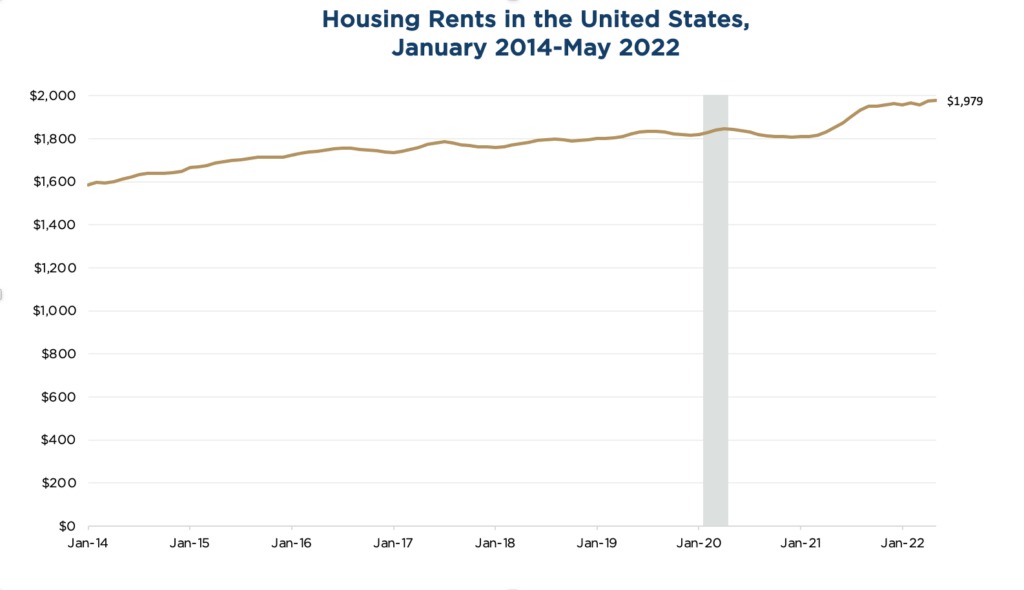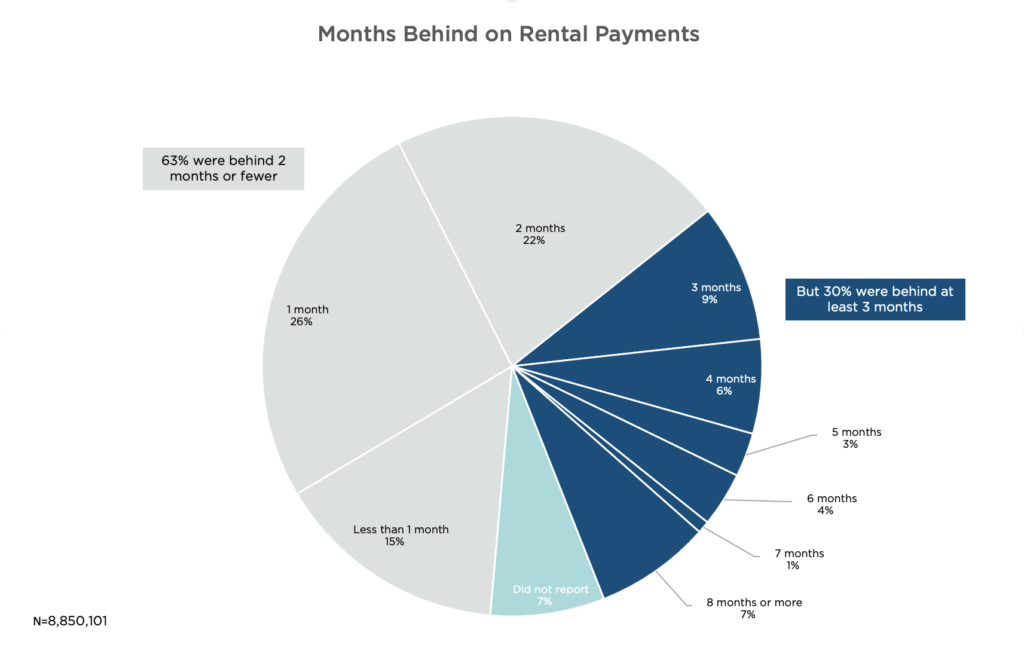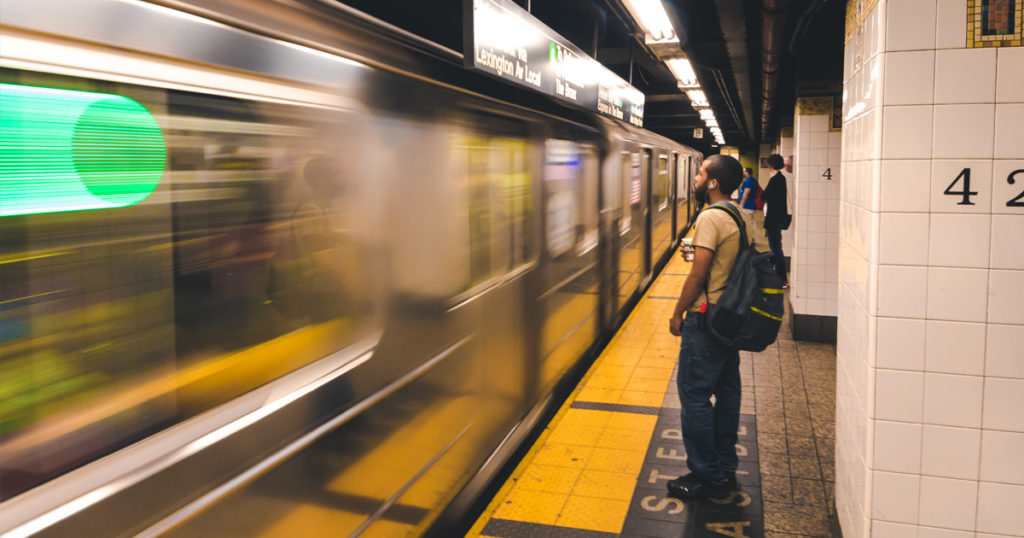Throughout the pandemic, many households have continued to struggle with housing insecurity.
Rising rents and persistent inflation increase the risk for people becoming homeless and serve as barriers to people who are trying to exit homelessness. In a 2020 study, researchers at the U.S. Government Accountability Office estimated that “a $100 increase in median rent was associated with a 9% increase in the estimated homelessness rate.”1 New research sheds light on the precariousness of people’s housing situations in the midst of historically high rent prices and inflation, which may lead to increases in homelessness if left unchecked.
Rent Inflation is a Concern

Rental prices have increased substantially, especially in the past year. In inflation-adjusted terms, the Zillow Observed Rent Index (ZORI)2 reports that the median rent increased by 15.9 percent in the last 12 months nationwide (ending in May 2022) and increased across all housing types. This increase is apparent in the graph above: rents were steadily increasing from January 2014 until January 2021, followed by a noticeable spike in rental costs.
While this increase occurred nationwide, certain areas took a harder hit. California cities San Jose, San Francisco, and Ventura led the nation with median rents exceeding $3,000/month, as of May 2022. However, the greatest increases in rent were concentrated in Florida, where rents rose more than 30 percent in Fort Meyers, Miami-Fort Lauderdale, and North Port-Sarasota-Bradenton within the span of the same year.
How Inflation Impacts the Ability to Pay for Housing
These staggering rent increases are happening as a broader inflation wave has hit the country. Inflation reached a 40-year peak of 8.6 percent from May 2021 to May 2022. Increased spending on essentials such as food, energy, transportation, and health care may cause households to fall behind on housing payments.
Inflation also limits households’ buying power as prices have been rising faster than income. The U.S. Bureau of Labor Statistics reported that average hourly earnings actually decreased 3 percent over the year when adjusted for inflation. Combined with the nationwide lack of affordable housing, households are struggling to keep up with the rent.
Older adults particularly feel this pressure. A combination of fixed incomes, climbing rents, and higher prices have caused increased risk of homelessness among this population. Some patronize food banks or skip meals just so that more of their Social Security income can go towards rent, while many providers report increases in the number of seniors they are serving.
Who Remains At Risk

Many renters in the United States remain at risk of not being able to stay in their homes—a pressure that disproportionately impacts people of color and low-income households. According to the latest U.S. Census Household Pulse Survey, which tracks how the COVID-19 pandemic has been impacting people’s lives in the United States, 8.8 million people were behind on their rent payments from April 27–May 9, 2022. This represents an increase of 1.7 million individuals from the same week one year ago. More than 60 percent were behind on only two months’ rent or less, suggesting that even a little rental assistance could help them catch up. Another 30 percent of people were more deeply in arrears, being at least three months behind.
Nearly half of those falling behind on rent also reported that they were “somewhat likely” or “very likely” to be evicted—the majority of whom were Hispanic or Black. One out of every 10 renters was “not at all confident” in their ability to pay the following month’s rent. This sentiment is largely due to these individuals not earning enough to cover their living expenses, and not from unemployment.
Closing the Gaps
Given the scope of the crisis, it’s up to the federal government to solve this problem to scale. In 2021, Congress created the Emergency Rental Assistance (ERA) program to provide billions of dollars in short-term aid to help keep families in their homes. State and local eviction moratoria have also helped low-income renters after the federal ban on evictions ended last August.
However, these are short-term measures not equipped to resolve a long-term problem. The National Low Income Housing Coalition estimates that 23 state grantees are on track to exhaust both rounds of ERA funding by year’s end. Smart use of remaining ERA and Coronavirus State and Local Fiscal Recovery Funds program funds is critical. Congress should create a permanent version of the ERA program. In the meantime, federal and local leaders must do everything they can to make existing resources available, equitable, and accessible to help low-income renters stay housed.
- These findings account for wages, unemployment, poverty, and other demographic and economic factors.
- The Zillow Observed Rent Index (ZORI) looks at the monthly market-rate rent for single-family and multi-family units in the United States and are adjusted for seasonal fluctuations in rent prices and housing stock.
Stay Updated: Solutions, Stories, and Ways to Make an Impact
Sign up to receive updates on the Alliance’s work, including the latest research, advocacy efforts, and real stories of progress — plus ways you can help drive lasting change.














